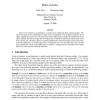Free Online Productivity Tools
i2Speak
i2Symbol
i2OCR
iTex2Img
iWeb2Print
iWeb2Shot
i2Type
iPdf2Split
iPdf2Merge
i2Bopomofo
i2Arabic
i2Style
i2Image
i2PDF
iLatex2Rtf
Sci2ools
123
click to vote
JIIS
2006
2006
Holes in joins
A join of two relations in real databases is usually much smaller than their cartesian product. This means that most of the combinations of tuples in the crossproduct of the respective relations do not appear together in the join result. We characterize these combinations as ranges of attributes that do not appear together. We sketch an algorithm for finding such combinations and present experimental results from real data sets. We then explore two potential applications of this knowledge in query processing. In the first application, we model empty joins as materialized views, we show how they can be used for query optimization. In the second application, we propose a strategy that uses information about empty joins for an improved join selectivity estimation.
Related Content
| Added | 13 Dec 2010 |
| Updated | 13 Dec 2010 |
| Type | Journal |
| Year | 2006 |
| Where | JIIS |
| Authors | Jarek Gryz, Dongming Liang |
Comments (0)

